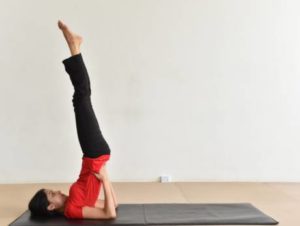Strengthen the Pelvic Floor of Postpartum Women with Yoga
By John M. de Castro, Ph.D.
“Yoga does not just change the way we see things, it transforms the person who sees.” ― B.K.S Iyengar
Childbirth and some surgeries, particularly hysterectomies can weaken the muscles that hold the pelvic organs in place. These muscles are referred to as the pelvic floor which fixes the bladder, uterus, and rectum in the pelvic cavity. These muscles are often weakened as a result of childbirth. This can lead to a state where the pelvic organs such as the bladder drop from the lower belly and push against the walls of the vagina. The most common symptom of pelvic floor weakness is feeling very full in the lower belly. Symptoms also include feeling as if something is falling out of the vagina, feeling a pull or stretch in the groin area or pain in your lower back, incontinence or needing to urinate a lot, having vaginal pain during sex, and constipation.
It is estimated that pelvic floor weakness affects about a third of women sometime during their lifetime. When mild to moderate in intensity it is usually left untreated, and the patient learns to cope with the symptoms. But in severe cases surgery is called for. Exercises to strengthen the muscles holding the organs in place can be helpful in relieving symptoms. Yoga training has been shown to be beneficial for a large array of physical and mental disorders including Pelvic Organ Prolapse. So, it makes sense to study the effectiveness of yoga exercise on the strength of the pelvic floor in postpartum women.
In today’s Research News article “The Effects of Yoga Exercise on Pelvic Floor Rehabilitation of Postpartum Women.” (See summary below or view the full text of the study at: https://www.ncbi.nlm.nih.gov/pmc/articles/PMC8808187/ ) Li recruited women in need of postpartum pelvic floor rehabilitation and provided them with myoelectric stimulation. They were assigned the to receive either no further treatment or to practice yoga for 10 weeks. They were measured before, and at 42 days and 3 months with pelvic ultrasound examination.
They found that the yoga group after training had significantly fewer ruptures in the pelvic floor, significantly better positioning of the rectum and bladder, significantly improved chest circumference, vital capacity, and movement and flexibility, and significantly lower levels of anxiety, depression, paranoia, and hostility.
These findings suggest that yoga practice strengthens the pelvic floor and the physician and psychological well-being of women postpartum.
”Yoga is the fountain of youth. You’re only as young as your spine is flexible.” ― Bob Harper
CMCS – Center for Mindfulness and Contemplative Studies
This and other Contemplative Studies posts are also available on Twitter @MindfulResearch
Study Summary
Li Q. The Effects of Yoga Exercise on Pelvic Floor Rehabilitation of Postpartum Women. J Healthc Eng. 2022 Jan 25;2022:1924232. doi: 10.1155/2022/1924232. PMID: 35126906; PMCID: PMC8808187.
Abstract
Rehabilitation of the pelvic floor after delivery is very important for women. Pelvic floor rehabilitation can speed up the recovery of the postpartum vagina and pelvic floor muscle tension and elasticity and have a good effect on the prevention and treatment of postpartum vaginal prolapse and relaxation, urinary incontinence and other pelvic floor disorders. Thus, this article focuses on yoga exercise to explore its impact on postpartum pelvic floor rehabilitation. This article uses electrical stimulation and the treatment of pelvic floor muscles combined with the posture recognition algorithm, the yoga rehabilitation training program that has the best effect on the parturient is obtained, and the yoga myoelectric stimulation combined method and the traditional myoelectric stimulation method are designed for comparison experiments. The experimental results show that the parturients who have undergone the combined method of yoga myoelectric stimulation, in the resting state, contraction state, and Valsalva state, the position of the bladder meridian, the position of the uterus, and the position of the rectal ampulla of the parturient have a significant recovery compared those who have undergone the traditional electromyography treatment. In addition, the average area of hiatus in the pelvic floor ultrasound examination in the control group 42 days postpartum was 12.2605 cm2, while the average area of the hiatus in the pelvic floor ultrasound examination in the experimental group 42 days postpartum was 10.788 cm2; the average area of hiatus in the pelvic floor ultrasound examination in the control group at 3 months postpartum was 11.4805 cm2, and the average area of hiatus in the pelvic floor ultrasound examination in the experimental group at 3 months postpartum was 8.9475 cm2. To sum up, yoga had a very significant improvement on the physical indicators and mental health of postpartum women.
https://www.ncbi.nlm.nih.gov/pmc/articles/PMC8808187/

